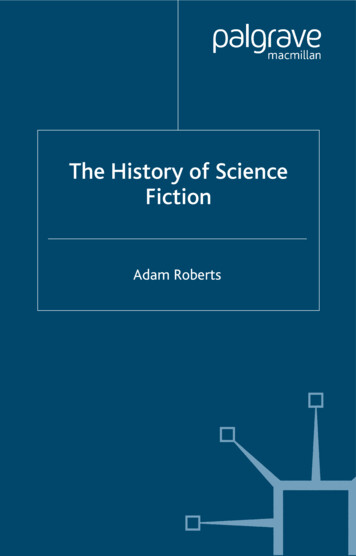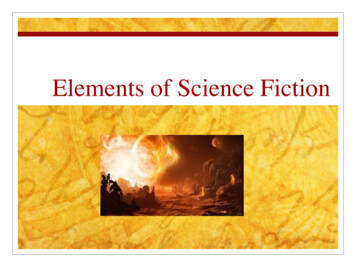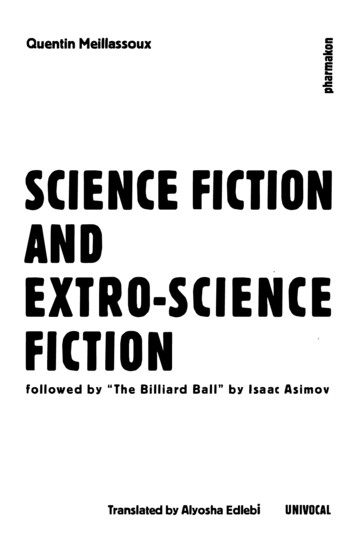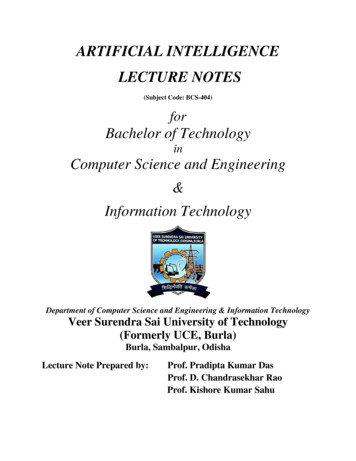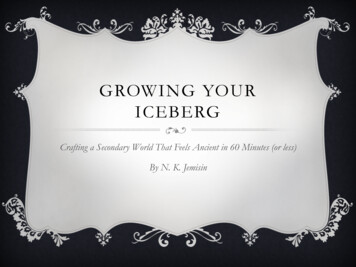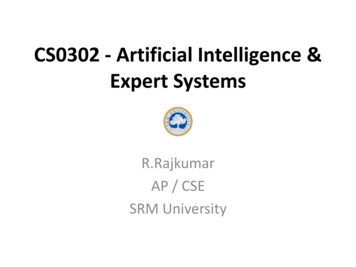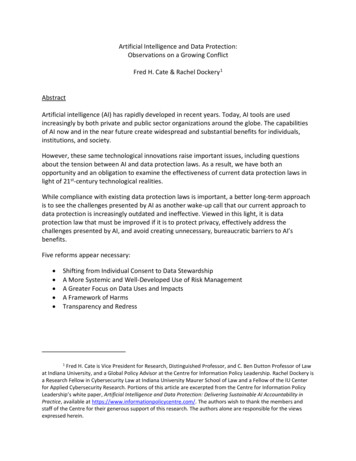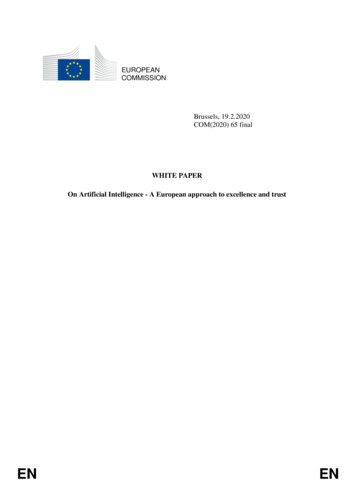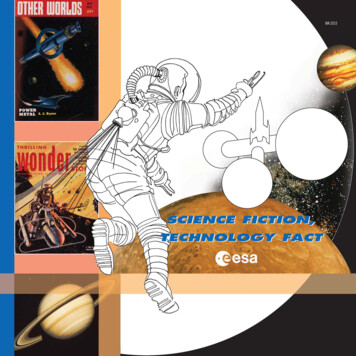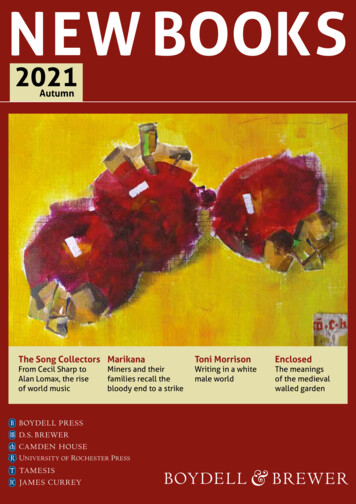
Transcription
ARTIFICIAL INTELLIGENCE IN SCIENCE FICTION
BODY, MIND, SOUL-THE 'CYBORG EFFECT':ARTIFICIAL INTELLIGENCE IN SCIENCE FICTIONBYDUNCAN LUCAS, B.A.A ThesisSubmitted to the School of Graduate Studiesin Partial Fulfilment of the Requirementsfor the DegreeMaster of ArtsMcMaster University Copyright by Duncan Lucas, August 2002
MASTER OF ARTS (2002)(English)McMaster UniversityHamilton, OntarioTITLE: Body, Mind, Soul-The 'Cyborg Effect': Artificial Intelligence in Science FictionAUTHOR: Duncan Lucas, B.A. (McMaster University)SUPERVISOR: Professor Joseph AdamsonNUMlBER OF PAGES: v, 18511
Abstract:Though this project is about representations of artificial intelligence (AI) in sciencefiction (SF), no discussion of 'artificial' intelligence could ever take place withoutconsidering 'real' intelligence. Consequently, at core and by default, this project is abouthuman intelligence. Artificial intelligence throws into relief the essence of being human asa tripartite construction of body, mind, and their synergistic combination, by creating anintelligent, dialogical, and interrogative entity as a comparative Other.Chapters one and two address two basic questions: What is science fiction? What isartificial intelligence? These evolve additional questions: How do science :fiction writersdelineate the physical and intellectual capabilities and capacities of humans versusmachines (in the broadest sense), their comparative behaviours, and thereby, considerhumanl methods for understanding our universe and our place in it? What place do SFwriters imagine machine intelligence taking in our world? What are the ethical, moral, andsocial implications for human verus machine inteHigence?Chapters three and four consider how authors construct Als, what physical formsthey might take, and the relative importance of the body versus the mind. The imaginativecreations are compared to actual develops in the science of AI, thereby revealing somesurprising prophecies. Discovered is that human beings are nervous about their owntechnological constructions, especially when those creations begin to match human intellectand mentation. Consequently, some of our worst bigoted behaviours are brought the fore. Idesignate two temporal periods as the 'animated automaton' (citing Frankenstein,Metropolis, R. UR) and the 'heuristic hardware' (2001: a Space Odyssey, Do AndroidsDream of Electric Sheep?, The Hitch Hiker's Guide to the Galaxy, and 1, Robot).Chapter five focusses on a single narrative (Galatea 2.2) as an excellentconsideration of the cmTent state of AI research and the development of ever more effectivesystems for processing information. It begins with observing a change in the scientificworldvriew and the change from energy to information as the fundamental reality. The AIchallenges a human to recognize and acknowledge humanity's own despotic and parodicbehaviours. By considering exactly how human beings learn, know, and remember, itthrows into dramatic relief our own assumptions about the superiority of humanintelligence.Chapter six looks at post-1980 literatures (Neuromancer, The Matrix, The DiamondAge, and Terminator) and the influence of the personal computer on the imaginations of SFwriters I. The narratives' complexities increase and the boundaries between assumed 'reality'and 'virtual reality' erode. Human beings are clearly anxious about increasingly powerfulthinking machines, probably because our confidence in the uniqueness and singularity ofhuman intelligence is challenged directly. The connection between body and mind is,paradoxically, both broken and affirmed, thus forcing humans to find ways to understandthe essence of consciousness, particularly as it may related to the 'soul.'Ultimately, AI could teach human beings about ourselves, and may force us to moreclearly define 'human being.' Potentially, though not an expressed goal, AI research couldunify hiumanity globally and help us to help ourselves in re-structuring economic,educational, social disparity.111
Ac1G1owledgements:Dr. Alvin Lee, Dr. Joe Adamson, Dr. Jean Wilson for their consistent encouragement andmento:r;ship - to say nothing of patience.Dr. ImJi'e Szeman, who assigned me the lowest undergraduate mark I ever received - andso raised the bar.My thesis committee: Dr. Joe Adamson, Dr. Imre Szeman, and Dr. Anne Savage. - I hopeit was worth it.Dr. Don Goellnicht and Dr. Roger Hyman for helping me to believe in myself and my workat the graduate level, and encouraging my continuing studies.To all my uncited undergraduate professors. If any of the ideas and information in thisthesis are yours but which I fail to ac1G1owledge, it is only because I learned so much that Ino longer know where it all came from. Please take it as a compliment that I was listeningon some level.My family and friends, of course, for their lillwavering support - and patience.My friend, lover, partner, my psycho-emotional foundation, Trish O'Meara, for makinghome home by affirming and demonstrating the true value of human life -- and heramazing patience. I love you, in body, mind, and soul.IV
Contents:Abstract: . ,.111AcknoWledgements: . ". ".IVIntroduction: Where are we going?2Part One: Conception. One: What is Science Fiction? Two: What is Artificial Intelligence?712Part Two: The Birth of Artificial Intelligence in Narrative. Three: The Animated Automaton. . . Four: Heuristic Hardware. . .48Part Three: An Evolution of Species. Five: What is Artificial Intelligence Now? . . Six: Body, Mind, Soul-The 'Cyborg Effect.' . .86109Part Four: Toward a New Tomorrow. Seven: What have we learned? . . . . . . . . . . . Conclusions: What do we want to be? . . . . . . . . . . . .15316622Synopses ofNarratives. .174Works Cited and Consulted. . .180v
F or man to tell how human life beganIs hard, for who himself beginning knew?(John Milton)1
Introduction: Where are we going?We can only see a short distance ahead, but we can see plenty there that needs to be done.(Alan Turing)This project is about representations of artificial intelligence in science fiction. Itbegins with the assumption that an artificial intelligence has demonstrated, or inevitablywill demonstrate, consciousness. My personal feelings on the likelihood of this scenario donot shape that statement; I accept the assumption because for the writers whom I consider inthis thesis it is 'true' as a narrative premise.No discussion of 'artificial' intelligence, however, can take place withoutconsidering 'real' intelligence. In an essay mixing "both computers and psyehology," writesMarvin Minsky, the "reason is that though we'd like to talk about making intelligentmachines, people are the only such intelligence we can imitate or study now" (in The Age ofIntelligent Machines 219). At core and by default, then, this project is about humanintelligence. From a human perspective, I will go8!step further and suggest that the onlyconscious intelligence we may ever acknowledge and recognize as 'legitimate' is the onewe wanl: to recognize as uniquely intelligent -our own. In the perhaps not too distantfuture, the term 'artificial intelligence' may become an oxymoron, and we may be forced todrop the prefix 'artificial' when it becomes prejudicial and denigrating. But most peoplebelieve the future has not yet been written .Writing an English Master's thesis with some understanding ofliterary principles isone praetice, but the scientific principles behind artificial intelligence (AI) are another2
discipline all tagether. Putting the twa inta a cahesive package requires explaratian andsynthesis based in the patential af free ranging thaught assaciatians. Far this reasan, I askreaders' indulgence and talerance. I think this is an apprapriate request in the science fictiancantext because the genre's readership, its 'fans,' are particularly accepting (fargiving? . )af astensibly ludicraus extrapalatians and speculatians. Arthur C. Clarke has written,"Althaugh it has became samething af a cliche, perhaps the mast impartant attribute afgaad science fictian-and the lOne that uniquely distinguishes it fram mainstreamfictian-· is its ability ta evake the sense afwander" (Greetings 404). Yet this praject's verylimitations farce me to cantain myself within a system, ta pravide baundaries and thusallaw the expansiveness ta wark in tension with an equal and appasing farGe. Bridging thegap between art and science, lOr at least bringing art inta dial ague with science, is afundamental mativatar behind this philasaphical treatise, lOr speculatian, or investigatian, lOrcreatian, lOr analysis, . lOr whatever it be judged.Daes it nat sametimes seem that Western society is steadily de-valuing literature'srale in and impartance ta sacial development by placing taa much emphasis an theSciences, as if they alane cauld understand and define the essence aflife and/ar beinghuman? Is lOur essence caded in lOur DNA and/or behaviaur, lOr lOur thaughts, lOr elsewhere?Science may pravide us with warkable 'laws' far making technalagy, but in the end "wepassesS! nathing but metaphars" ("On Truth and Lies" 83) as Friedrich Nietzsche saelaquently declared. The "clever beasts" (79) af Earth are a fartuitaus, explaitive speciesalive an an abscure little marble dangling, spinning, and swinging an a Nathingness amid avast Incamprehensian. But are we accepting respansibility far lOur behaviaurs? Or are we3
becoming increasingly arrogant about our knowledge, convincing ourselves that themendacious is 'solid' and 'real,' and thus, we become increasingly ignorant? "A newscientific truth does not triumph by convincing its opponents and making them see the light,but rather because its opponents eventually die out, and a new generation grows up that isfamilial" with it" (Max Planck as quoted in The Great Thoughts 333). Literature can not besubjected to scientific experimentation, but then neither can much of 'authorized' or'official' theoretical physics, or human psychology. 'Good' scientists know this, implicitlyunderstanding their task when they speak of 'describing' unseeable yet measurable physicalproperties. In his introduction to Vehicles: Experiments in Synthetic Psychology (1984),"Let the Problem of the Mind Dissolve in Your Mind," Valentino Braitenberg writes:This is an exercise in fictional science, or science fiction, if you likethat better. Not for amusement: science fiction in the service of science. Orjust science, if you agree that fiction is part of it, always was, and alwayswill be as long as our brains are only minuscule fragments of the universe,much too small to hold all the facts of the world but not too idle to speculateabout them. (1)Literature's value is in helping to develop an understanding of what means 'human-being'(nolID sense) and 'human being' (verbal sense). 'Human being' might be better thought ofas not a thing, but an action, a becoming, a creating, a doing, a process. Artificialintelligence throws into relief the essence of being human by creating an intelligent andinterrogative entity as a comparative Other without resorting to inventing gods as simplydisplaced and 'elevated' humans, nor anthropomorphically endowing the obviouslyunendowable inanimate .for me, the humanities seem threatened by utter de-valuation within the currentcapitalist driven, political environment of the Western academy because it places too much4
emphasis on business and technology. But the humanities may simply be in transition, in are-valuing process. Humans continue to produce cultural, literary artifacts -- films, novels,poems, and even video games with narrative undetpilmings -literature itself being onlyone among many' arti-types.' Being contemporary with newly emerging works, we may notyet recognize their long term, individual import. Which oftoday's works will endure the'test oftime'? Alas, "Ars Zonga, vita brevis" (Hippocrates). In light of these artifacts,themselves so invested in creating a range of archetypes, we can conceive of and argue forthe Imaginative itself as the value added.Story telling must have fundamental human value because every person in everyculture through all of history has told stories; we share anecdotes with friends; we recalllived events as narratives, a meaning-making process; we seek, in the remembering andtelling of our daily stories, to structure and shape life cohesively. Whether we are 'right' or'wrong' is surely less important that the process itself. Life is activity; value is added.Entertainment, then, is a social value, and there is no reason why entertainment can not beas instructive (perhaps even implicitly prescriptive) as it is meaning-making. Litterateursare simply more sophisticated at imagining structures and meanings than most people, andmore committed to committing their ideas to cultural remembrance. -Van Gogh was abetter painter than most of us too.At some level, we all engage in the scientific process everyday as we analyse, reflecton, and conclude from, sensually gathered, empirical data. This is the daily experiencecalled living, a process made so mundane by its very constancy that it becomes a forgetting.Rational analysis and creativity are not separate (or separable) intellectual processes, ofcourse, though they can be made discrete. They do and must work together. Curiously,)5\
artificial intelligence researchers found mimicking human logic-thinking an easy problem tosolve, while creative and associative thinking has frustrated them. Yet, in the wake ofKierkegaard's either/or distinctions, we often seem to accept individual thinking processesas either rational or not, and, in a culture too heavily biassed in favour of the rational, weeasily dismiss as a non-value-added social exercise, the creative, the imaginative, thespeculative. They make nothing. But they might describe anything and everything.One time, standing puny and in awe of the aurora borealis, I remember hearing anearby person ask, "What causes it?" 'Who cares?' I thought. 'Ask a poet.' Yet, even wordsfailed th.e moment. Both scientific actuality -a particular particulate solar wind collidingwith the atmosphere while bending around Earth's magnetism -and poetic expressionwere meaningless under the shadow of these seemingly audible northern spirit wisps, a duetof stardust and night, a visual song of shining shadows, Sirens singing of light and night, ofmagnificence and majesty and marvel. Magnetism or magic: Is there really a difference?6
Part One: Conception.One: What is Science Fiction?A new species would bless me as its creator and source;many happy and excellent natures would owe their being to me.(Mary Shelley)This is-Hubris clobbered by nemesis.(Brian Aldiss)Science fiction is a 'slippery' term which might seem easily understood; uponreflection, however, it becomes difficult to define precisely. "If you have to ask whatscience fiction is, you'll never know" (anonymous quote used by Clarke, Greetings 398).According to my Oxford Reference Dictionary, science fiction is "a class of prose narrativewhich assumes an imaginary technological or scientific advance, portrays space travel orlife on other planets, or depends upon a spectacular change in the human environment."This is not a good definition. Science fiction need not be prose, or even narrative, thoughthese generic approaches have so far proved better suited to accomplishing writers' goals.Science fiction is dependant not on fann but on content. Rhetorically, the definition impliesa non-reality, an "imaginary" world by using the word "assumes" as if science fictionwriters pluck possibilities ex nihilo from Imagination without necessarily considering theirviability, plausibility, likelihood, or functionality. This is not so. Science fiction writers areespecially interested in and informed about 'cutting edge' science and technology, and theirmajor ideas are extrapolations from and speculations about the effects of scientific7
discoveries and developments. The problem is, in part, indelibly connected to a vaguedistinction between fantasy fiction and science fiction. If you enter a bookstore, you willoften fil1d the singular marketing category' science fiction and fantasy' as if these twogenres can and should be lumped together.Fantasy requires the acceptance of, belief in, working assumption and useof whatwe call 'magic,' a character's agency and/or power to influence a physical world withpurpose but without explanation, which is regarded as irrelevant or subservIent to theauthor's desired effect-objective, the result. Fantasy does not care how 'it' is done, only thatit is done and why it needs to be done. In 'reality,' we do not accept the notion that a personcan simply snap a finger or wiggle a nose, or utter' shazam,' to produce an actual, physicaleffect. The rules of physics do not (have to) apply in fantasy. lR.R. Tolkien's The Lord ofthe Rings is a current popular, resurgent example.Science fiction, however, assumes that character (usually human) agency has anexplanation and executes power with deference to scientific principles. Even when positinga 'magical' uber-character who implicitly or explicitly wields mysterious powers, or causesphysical change and/or influence beyond 'realistic' comprehension levels, science fictionnonetheless implies that an explanation for the agency is not only possible but desirable bysuggesting that the 'miraculous' powers circumventing the 'ordinary' laws of nature have adefinite source in an accessible knowledge system, though the implied specific knowledgeoften remains assumed, postulated, or beyond the current database of a given epoch.Science fiction does not need to provide an explanation, only infer one exists. A character'spower may appear magical when considered. from a position of relative ignorance. If atwenty-first century person time travelled back to Plato's Greece with a lighter, might that8
person not possess a 'magic talisman' which, for us, is a mundane technological device?Today, we have little trouble imagining a technological device, say a 'ray-gun,' though wehave never held one. The essential technology exists; our imaginations can extrapolate the'reality. 'Baving delineated and separated science fiction from fantasy, I now restore theambiguity with Arthur C. Clarke's 'third law oftechnology': "Any sufficiently advancedtechnology is indistinguishable from magic" (Greetings 413).a Further, given genericflexibility and the possibility of works embodying several categories (realism, romanticism,myth, gothic, etc.) simultaneously, a text may, at any time, shift its relative position, and aparticular story can conceivably slide into the realm of science fiction as its existencemarches into the future. We can conceive, then, of a range of possibilities for characteragency with 'pure' fantasy, Northrop Frye's "romance mode" (Anatomy 33), defining oneend of a scale and 'hard' science (high/low mimetic mode) defining the other end. 1[n 1816, Mary Shelley published the first genuine SF novel, Frankenstein. Hernovel is (has been labelled) fantasy, gothic, 'gothic romance,' horror, social satire, but it isnot often referred to by the 'science fiction' appellation, except by SF admirers. Mind you,they are probably most qualified to decide. In Trillion Year Spree: the History o/ScienceFiction, Brian Aldiss 2 observes that at the time of publication, the "division between the1Taking my lead from Brian Aldiss, I shall henceforth use the abbreviation 'SF.' "That down-marketappellation 'sci-fi', sometimes heard on the lips of the would-be trendy in the media and elsewhere, ispurposely avoided. We bow to the fact that much of what passes for science fiction these days is nearerfantasy. SF can, after all, be imagined to stand for science fantasy, as it can for speculative fiction (fo:r thosewho are attached to that te:rm)" (Trillion Year Spree 20).2A competent SF writer himself, Aldiss' excellent and comprehensive (and substantial) volume mapsmajor comtributions to SF, including a detailed accounting of Mary Wollstonecraft Shelley"s (nee Godwin)influences, and the literary, scientific, and intellectual atmosphere of her time, place, and experience.9
arts and sciences had not then grown wide" (30). Talking about the "uniquely innovative"(39) features of Frankenstein, he writes:Interest has always centred on the creation of the nameless monster.This is the core of the novel, an experiment that goes wrong-a prescriptionto be repeated later, more sensationaUy, in Amazing Stories and elsewhere.Frankenstein's is the Faustian dream of unlimited power, but Frankensteinmakes no pacts with the devil. 'The devil' belongs to a relegated system ofbelief. Frankenstein's ambitions bear fruit only when he throws away his oldreference books from a pre-scientific age and gets down to some research inthe laboratory. This is now accepted practice, of course. But what is nowaccepted practice was, in 1818, a startling perception, a small revolution.(39-40)Aldiss also points to a fundamental requirement in the scientific process, the authenticationand confirmation of a discovery through an experiment's repeatability: "As if to dispel anydoubts about her aversion to 'jiggery-pokery magic', Mary makes it plain that her centralmarvel shares the essential quality of scientific experiment, rather than the hit-and-miss oflegerdemain. She has Frankenstein create life a second time" (41).Mary Shelley'S ideas are not ex nihilo creations, but belong to the intellectualspeculation in her time: "Among his other capacities, Erasmus Darwin [grandfather ofCharles Darwin] was a copious-and famous-versifier. In his long poems he laid out hisfindings on evolution and influenced the great poets of his day" (Aldiss 30);, and, fromMary Shelley'S own preface to her novel: "The event on which this fiction is founded hasbeen supposed, by Dr. Darwin and some of the physiological writers of Germany, as not ofimpossible occurrence" (Frankenstein xiii). In her introduction, she explicitly indicates herintent was to write a 'ghost' story, yet scientific knowledge and experimentation are a vitalimpetus in the tale. Victor Frankenstein's skills are presented as those of a scientist,. or moreaccurately a 'natural philosopher,' pursuing discovery. His actions are posited as empirical.10
The litmus test for science fiction is whether or not one can remove reference to scienceand/or explanation of agency without altering the essential story. With Frankenstein, this isnot possible. Frankenstein, therefore, is science fiction.Frankenstein marks not only the beginning of SF but, relevant to the purposes ofthis proj ect, it is also antecedent to the science broadly termed 'artificial intelligence.'Shelley was, after all, representing the 'manufacturing' of a sentient being, a. thinking,nameless entity capable of saying, "I." Up to this point, narratives dealing with the artificialcreation of 'humanoid' Hfe, or imitations of humans and their behaviours, paradoxicallybelong in the religious-literary tradition and mystical realm as with the Golem, the animatedclay figure in Hasidic Jewish mythology, and Ovid's Pygmalion and Galatea tale inMetamorphosis. 3 Shelley's fundamental differentiation is animation not by magic or thesupernatural, not by the gods, but by a man - selfishly, hopefully, foolishly, blindly: "The'vital spark' is imparted to the composite body. Life is created without supernatural aid.Science has taken charge. A new understanding has emerged" (Aldiss 40). That newunderstanding, so familiar to us today, is the ability to manipUlate the 'natural order'purposefully in the interest of satisfying humans' curiosities and multifarious desires.As this project evolves, the full implications of Shelley's 'vision' will becomeclearer and, I believe, demonstrate SF's primary and vital social function in our technologydriven culture: the speculative and experimental testing of scientific principles extrapolatedto a time of crisis.3 See Samuel Holmes Vasbinder's excellent account, Scientific Attitudes in Mary Shelley's Franker.!stein,particularly chapter four, "Early Literature on Artificial Humans."11
Two: What is Artificial Intelligence?AI is the study of how to make computers do things at which, at the moment, people arebetter. (Elaine Rich)Artificial Stupidity (AS) may be defined as the attempt by computer scientiststo create computer programs capable of causing problemsof a type normally associated with human thought.(WaHace Marshall)With one small mechanical invention, the flying shuttle, Western civilization took agiant technological leap in the 18th century; the industrial revolution began. In The Age ofIntelligent Machines (1990), 1 artificial intelligence researcher and entrepreneur RaymondKurzweil suggests that the computer age is a second industrial revolution. The distinction issimple: "The Industrial Revolution of the last two centuries-the first Industrial Revolution-was characterized by machines that extended, multiplied, and leveraged our physicalcapabiHties . The second industrial revolution, the one that is now in progress, is basedon machines that extend, multiply, and leverage our mental abilities" (Intelligent 7).Computing, as we understand it today, was initiated by Charles Babbage in 1821with his invention, the Difference Engine, and its later refinement, or 'evolution,' theAnalytic Engine (AE). He never completed its construction, however. HistoricallyIThis essay owes a large debt to Kurzweil's book. Over five hundred pages long, it sununarizes andoverviews the AI industry as of 1990, the first seventy pages alone dealing with the philosophicalfoundations, particularly around issues of language, communication methods, and word definitions, plushuman psychology, thought and emotion, plus again theoretical physics, mathematics and electronics .Reading it proved to be a 'mind bender.'12
significant as the first 'programmable' device using "a punched-card reader inspired by theJacquard looms, automatic weaving machines controlled by punched metal cards"(Kurzweil, Intelligent 165), the AE would have been capable of canying out logicalcomputation. Programming itself was developed by the daughter of poet Lord Byron, LadyAda Lovelace, who is responsible for inventing "the programming loop and the subroutine"The term 'artificial intelligence' (AI) was coined in 1956 at the Dartmouth SummerResearch Project on Artificial Intelligence. Previously, in 1950, British mathematician AlanTuring explored and explained many ofthe mathematic conditions, with large philosophicalimplications, for nascent AI research in his article "Computing MachinelY andIntelligence." Most impOliantly, Turing proposed what is now known as the 'Turing test.'The theoretical test for machine intelligence, it is an elegant and simple exam. (And I wouldwager not a few humans are capable of 'failing' this unfailable test.) He asks a simplequestion: "Can machines think?" Immediately recognizing the question's problematicdependence on definitions for 'machine' and 'think,' he writes: "Instead of attempting sucha definition I shall replace the question by another, which is closely related to it and isexpressed in relatively unambiguous words" (Turing 433).He called the new problem the 'imitation game': One man (A) and one woman (B)are placed in a closed room. Another man (C), the 'interrogator,' communicates with A and2The "only legitimate child of Lord Byron, the poet . Ada Lovelace is regarded as the world's firstcomputer programmer and has been honored by the United States Defense Department, which named itsprimary programming language, Ada, after her" (Kurzweil, Intelligent 167).13
B usinga teletype machine only (to mask their voices) and may ask any question(s).3 Cmust now determine which of A or B is the woman. A, however, is trying to fool C intochoosing him as her. B's objective is to help C confirm her identity. How long will C taketo correctly identify B as the woman? Having posited this scenario: "We now ask thequestion, 'What will happen when a machine takes the part of A in this game?' Will theinterrogator decide wrongly as often when the game is played like this as he does when thegame is. played between a man and a woman? These questions replace our original, 'Canmachines think?'" (Turing 434). As of2002, no machine has come close to passing thistest, except in literature. In Arthur C. Clarke's 2001: A Space Odyssey, HAL "could passthe Turing test with ease" (2001 97).Since its 1950 publication, the Turing test's basic premise has been abused at timeswhen scientists attempted to limit the range of questions. Turing's intent allows any and allquestions. But Turing placed his own limitations on the game; he allowed that only digitalcomputers would play. In simplified form, only one person and one computer need beinvolved. If a computer can sustain a dialogue sufficiently to 'fool' the interrogator, themachine 'wins.' According to philosopher Daniel Dennett, "Turing proposed that anycomputer that can regularly or often fool a discerning judge in this game would beintelligent, a computer that thinks, beyond any reasonable doubt" (in The Age of IntelligentMachines 48). Novelist Richard Powers writes: "A perfect, universal simulation ofintelligen
This is an exercise in fictional science, or science fiction, if you like that better. Not for amusement: science fiction in the service of science. Or just science, if you agree that fiction is part of it, always was, and always will b
